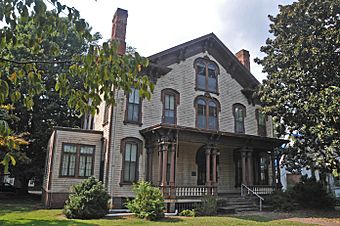Andrews-Duncan House facts for kids
Quick facts for kids |
|
|
Andrews-Duncan House
|
|

Andrews-Duncan House, 2007
|
|
| Location | 407 North Blount Street Raleigh, North Carolina, U.S. |
|---|---|
| Area | 1 acre (0.40 ha) |
| Built | 1874 |
| Architect | George S. H. Appleget |
| Architectural style | Italianate |
| NRHP reference No. | 72000998 |
| Added to NRHP | January 20, 1972 |
The Andrews-Duncan House is a historic building in Raleigh, North Carolina. It was built in 1874 for a well-known businessman. The house has an Italianate style. It was designed by architect George S. H. Appleget.
This house was added to the National Register of Historic Places (NRHP) in 1972. This means it is a special place that is important to history. The state government now owns the house. A very old tree, named after a presidential candidate, once stood behind the house. A special marker tells its story.
Contents
History of the Andrews-Duncan House
In April 1873, Alexander Boyd Andrews bought a piece of land. He was a railroad leader and a former captain in the Confederate States Army. The land was in downtown Raleigh. Andrews chose George S. H. Appleget to design his home. Appleget was a famous architect.
Appleget also designed Estey Hall at Shaw University. He designed the Heck-Andrews House too, which is right next door. His most famous public building is the Cabarrus County Courthouse. Alexander Andrews lived in the house until he passed away in 1915.
Later, in 1919, the Andrews family sold the house. It was bought by Laura Duncan Pearson. Her family owned the house for many years. Today, the building is used as offices for North Carolina state government workers.
The house became a Raleigh Historic Landmark in 1972. A historical marker outside the building shares information about Alexander B. Andrews. It says he was a "Railroad builder and financier."
The Famous Henry Clay Oak
A very large white oak tree once stood behind the house. People called it the "Henry Clay Oak." It was about 100 feet tall and very wide. Experts thought it was between 200 and 350 years old.
The tree was famous because of a story about Henry Clay. He was a politician. In 1844, he supposedly wrote a letter under this tree. In the letter, he said he was against Texas joining the United States. Many people believe this letter caused him to lose the 1844 United States presidential election.
Sadly, the tree was cut down in 1991. It had been damaged by weather and a root disease. Two historical markers now stand where the tree once was. They tell the story of Henry Clay and the famous oak.
Architecture of the House
The Andrews-Duncan House is a large, two-and-a-half story building. It is designed in the Italianate style. This style was popular in the late 1800s. The house has stone walls in the basement. The outside is covered with overlapping wooden siding.
The roof is a gable roof. It has a false gable on the front and back. The front of the house has five sections, called bays. The main entrance has double doors. Above the doors is a round window with two lights, called a lunette. The doors are framed by decorative wood.
A porch with a hip roof covers the three middle sections of the front. It is held up by pairs of posts. These posts have flat edges, called chamfered posts. There is a decorative band, called a frieze, above the posts. It has brackets underneath.
The second floor and the top section of the front have pairs of round-headed windows. These windows are also on the sides of the house. The sides have four bays each. There is an enclosed addition on the south side of the house. The back of the house also has a porch. Behind the house, there is a carriage house. It is also designed in the Italianate style.
Images for kids




